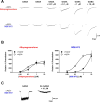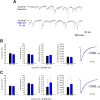Rescue of deficient amygdala tonic γ-aminobutyric acidergic currents in the Fmr-/y mouse model of fragile X syndrome by a novel γ-aminobutyric acid type A receptor-positive allosteric modulator
- PMID: 26308557
- PMCID: PMC5544527
- DOI: 10.1002/jnr.23632
Rescue of deficient amygdala tonic γ-aminobutyric acidergic currents in the Fmr-/y mouse model of fragile X syndrome by a novel γ-aminobutyric acid type A receptor-positive allosteric modulator
Abstract
Alterations in the ratio of excitatory to inhibitory transmission are emerging as a common component of many nervous system disorders, including autism spectrum disorders (ASDs). Tonic γ-aminobutyric acidergic (GABAergic) transmission provided by peri- and extrasynaptic GABA type A (GABAA ) receptors powerfully controls neuronal excitability and plasticity and, therefore, provides a rational therapeutic target for normalizing hyperexcitable networks across a variety of disorders, including ASDs. Our previous studies revealed tonic GABAergic deficits in principal excitatory neurons in the basolateral amygdala (BLA) in the Fmr1(-/y) knockout (KO) mouse model fragile X syndrome. To correct amygdala deficits in tonic GABAergic neurotransmission in Fmr1(-/y) KO mice, we developed a novel positive allosteric modulator of GABAA receptors, SGE-872, based on endogenously active neurosteroids. This study shows that SGE-872 is nearly as potent and twice as efficacious for positively modulating GABAA receptors as its parent molecule, allopregnanolone. Furthermore, at submicromolar concentrations (≤1 μM), SGE-872 is selective for tonic, extrasynaptic α4β3δ-containing GABAA receptors over typical synaptic α1β2γ2 receptors. We further find that SGE-872 strikingly rescues the tonic GABAergic transmission deficit in principal excitatory neurons in the Fmr1(-/y) KO BLA, a structure heavily implicated in the neuropathology of ASDs. Therefore, the potent and selective action of SGE-872 on tonic GABAA receptors containing α4 subunits may represent a novel and highly useful therapeutic avenue for ASDs and related disorders involving hyperexcitability of neuronal networks.
Keywords: GABA; GABAA receptor; amygdala; fragile X syndrome; positive allosteric modulator.
© 2015 Wiley Periodicals, Inc.
Conflict of interest statement
GM-B, CML, FGS, AJR, MAA, and JJD are currently or were formerly employed by Sage Therapeutics, Inc. Joshua G Corbin and Molly M Huntsman served as paid consultants on the Sage Therapeutics Scientific Advisory Board.
Figures



Similar articles
-
Deficient tonic GABAergic conductance and synaptic balance in the fragile X syndrome amygdala.J Neurophysiol. 2014 Aug 15;112(4):890-902. doi: 10.1152/jn.00597.2013. Epub 2014 May 21. J Neurophysiol. 2014. PMID: 24848467 Free PMC article.
-
Defective GABAergic neurotransmission and pharmacological rescue of neuronal hyperexcitability in the amygdala in a mouse model of fragile X syndrome.J Neurosci. 2010 Jul 21;30(29):9929-38. doi: 10.1523/JNEUROSCI.1714-10.2010. J Neurosci. 2010. PMID: 20660275 Free PMC article.
-
Context-Dependent Modulation of GABAAR-Mediated Tonic Currents.J Neurosci. 2016 Jan 13;36(2):607-21. doi: 10.1523/JNEUROSCI.2047-15.2016. J Neurosci. 2016. PMID: 26758848 Free PMC article.
-
The basolateral amygdala γ-aminobutyric acidergic system in health and disease.J Neurosci Res. 2016 Jun;94(6):548-67. doi: 10.1002/jnr.23690. Epub 2015 Nov 19. J Neurosci Res. 2016. PMID: 26586374 Free PMC article. Review.
-
Insights into GABAAergic system deficits in fragile X syndrome lead to clinical trials.Neuropharmacology. 2015 Jan;88:48-54. doi: 10.1016/j.neuropharm.2014.06.028. Epub 2014 Jul 10. Neuropharmacology. 2015. PMID: 25016041 Review.
Cited by
-
Channelopathies in fragile X syndrome.Nat Rev Neurosci. 2021 May;22(5):275-289. doi: 10.1038/s41583-021-00445-9. Epub 2021 Apr 7. Nat Rev Neurosci. 2021. PMID: 33828309 Free PMC article. Review.
-
Developmental Disruption of GABAAR-Meditated Inhibition in Cntnap2 KO Mice.eNeuro. 2017 Sep 21;4(5):ENEURO.0162-17.2017. doi: 10.1523/ENEURO.0162-17.2017. eCollection 2017 Sep-Oct. eNeuro. 2017. PMID: 28966979 Free PMC article.
-
Of Men and Mice: Modeling the Fragile X Syndrome.Front Mol Neurosci. 2018 Mar 15;11:41. doi: 10.3389/fnmol.2018.00041. eCollection 2018. Front Mol Neurosci. 2018. PMID: 29599705 Free PMC article.
-
Decreased surface expression of the δ subunit of the GABAA receptor contributes to reduced tonic inhibition in dentate granule cells in a mouse model of fragile X syndrome.Exp Neurol. 2017 Nov;297:168-178. doi: 10.1016/j.expneurol.2017.08.008. Epub 2017 Aug 16. Exp Neurol. 2017. PMID: 28822839 Free PMC article.
-
Body fluid levels of neuroactive amino acids in autism spectrum disorders: a review of the literature.Amino Acids. 2017 Jan;49(1):57-65. doi: 10.1007/s00726-016-2332-y. Epub 2016 Sep 29. Amino Acids. 2017. PMID: 27686223 Free PMC article. Review.
References
-
- Amaral DG, Bauman MD, Schumann CM. The amygdala and autism: implications from nonhuman primate studies. Genes Brain Behav. 2003;2:295–302. - PubMed
-
- Bäckström T, Bixo M, Johansson M, Nyberg S, Ossewaarde L, Ragagnin G, Savic I, Strömberg J, Timby E, van Broekhoven F, van Wingen G. Allopregnanolone and mood disorders. Prog Neurobiol. 2014;113:88–94. - PubMed
-
- Baron-Cohen S, Ring HA, Bullmore ET, Wheelwright S, Ashwin C, Williams SC. The amygdala theory of autism. Neurosci Biobehav Rev. 2000;24:355–364. - PubMed
-
- Bear MF, Huber KM, Warren ST. The mGluR theory of fragile X mental retardation. Trends Neurosci. 2004;27:370–377. - PubMed
Publication types
MeSH terms
Substances
Grants and funding
LinkOut - more resources
Full Text Sources
Other Literature Sources
Medical
Molecular Biology Databases
Research Materials

